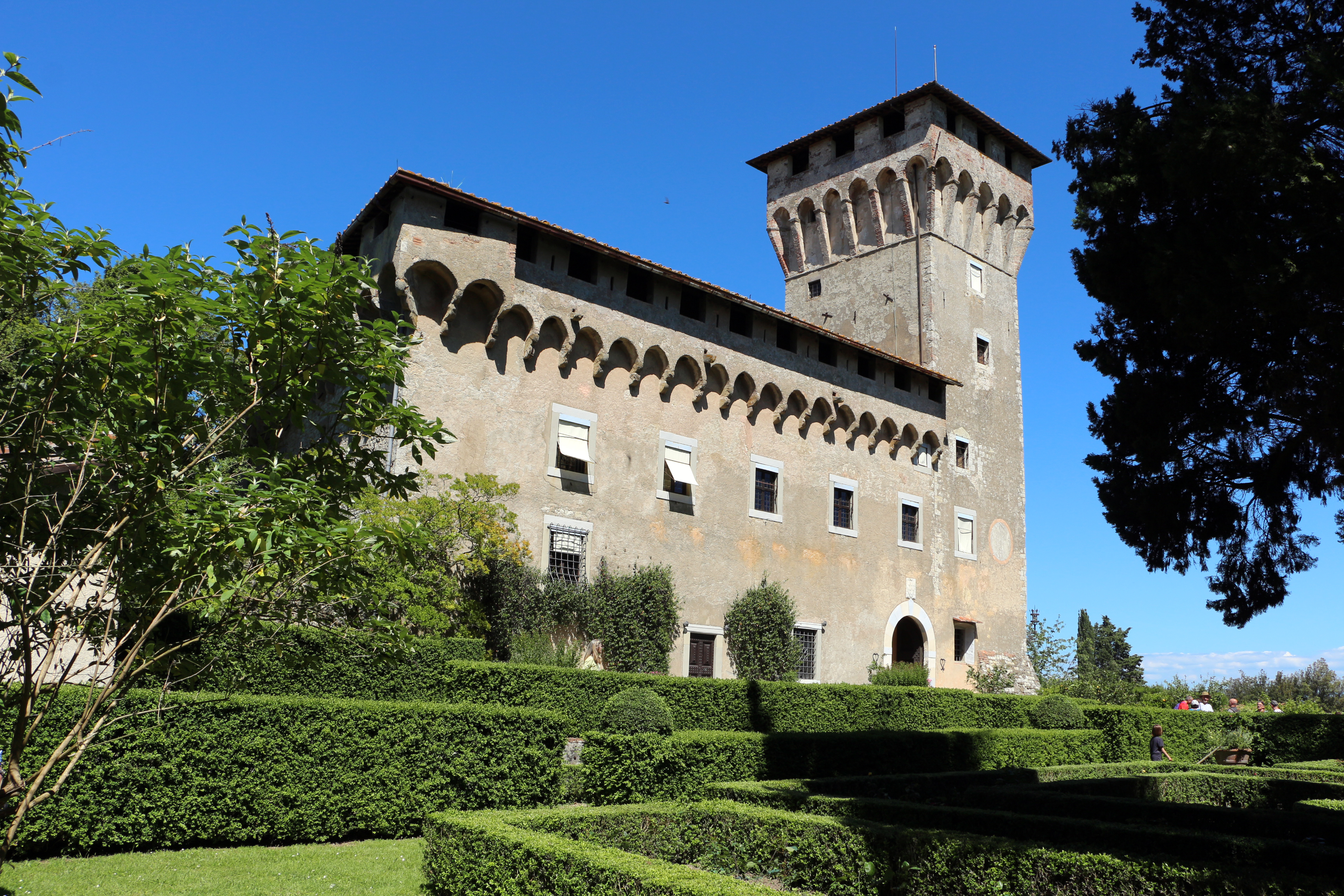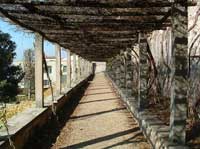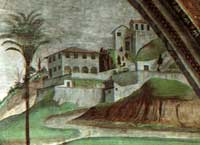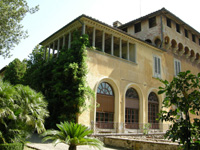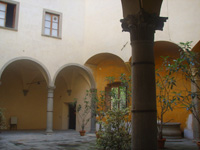| Medici Villas in Tuscany Enlarge map |
De Medici villa’s en tuinen in Toscane |
De Medici villa's zijn een reeks landelijke complexen in de buurt van Firenze, die eigendom waren van leden van de familie de' Medici tussen de 15e en 17e eeuw. Het waren prachtige residenties die rijk waren aan kunstwerken. Zo werd Botticelli's Primavera geschilderd voor de Villa in Castello. De villa’s waren zowel uitstekende economische investeringen die voor een constante bron van inkomsten zorgden, als uitingen van hun macht en rijkdom. Omwille van hun belangrijke cultuurhistorische waarde werden 12 villa’s en 2 tuinen toegevoegd aan het Unesco wereldpatrimonium. In 1569 verhief paus Pius V het hertogdom Florence, dat in bezit was van de Medici tot groothertogdom Toscane. De titel groothertog was nieuw en zou uniek blijven tot 1806, toen Napoleon aan een aantal Duitse vorsten de titel groothertog verleende. Elk lid van de Medici familie had zijn eigen landgoed. Afhankelijk van de seizoenen, verhuisde de familie de’ Medici van de ene villa naar het andere; voor jagen verbleven zein Pratolino en Cafaggiolo, in de winter, op zoek naar lagere temperaturen, verbleven ze aan zee. In 2013 werden de volgende Medici villa's toegevoegd aan de Werelderfgoedlijst van UNESCO. Het gaat om twaalf villa’s en twee tuinen: Villa di Cafaggiolo, Villa del Trebbio, Villa di Careggi, Villa Medici di Fiesole, Villa di Castello, Villa di Poggio a Caiano, Villa di La Petraia, Villa di Cerreto Guidi, Palazzo di Saravezza, Villa La Magia, Villa di Artimino, Villa di Poggio Imperiale, Boboli Gardens and Pratolino Park. Naast de hier vermelde Toscaanse villa's hadde de'Medici ook enkele paleizen in Firenze:
en beschikten ze over de Villa Medici in Rome. |
Kaart van de De' Medici villa’s en tuinen in Toscane
|
|
De Medici villa’s en tuinen in Toscane
|
||
Castello del Trebbio |
||
Castello del Trebbio [3]
|
||
De Villa Medicea del Trebbio ligt in de buurt van Scarperia e San Piero in Mugello, de regio die het thuisland was van de' Medici. In de beroemde lunette van Giusto Utens heet de villa Il Trebbio.
|
||
|
||
Castello di Cafaggiolo |
||
 |
||
De Villa Medicea di Cafaggiolo
|
||
De Villa Medicea di Cafaggiolo ligt in de buurt van de Toscaanse stad Barberino di Mugello, ongeveer 25 kilometer ten noorden van Firenze. De Mugello regio was het thuisland van de Medici. De villa was een van de oudste Medici villa’s.
|
||
Villa di Poggio a Caiano |
||
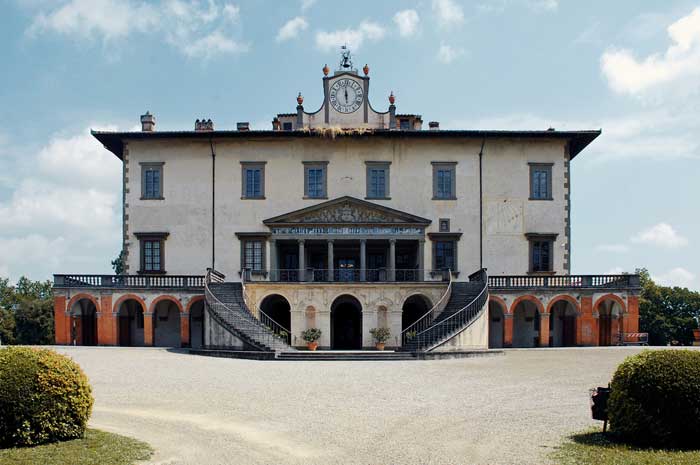 |
||
Villa Medicea at Poggio a Caiano |
||
The Villa is an architectonic masterpiece by Giuliano da Sangallo. Villa Poggio a Caiano is an interesting example of early Renaissance architecture that conserved noteworthy frescos of some of the most important Florentine paintings of the 16th century (Pontormo and Andrea del Sarto). In 1473 a ruined fortified house at Poggio a Caiano, called the Ambra, and land and a mill owned by Giovanni Rucellai, were bought by Lorenzo de' Medici. First, agricultural improvements were carried out, then in 1485 work started on the Medici Villa del Poggio, the "Villa on the Hill", to designs by Giuliano da Sangallo commissioned by Lorenzo. Address: Piazza dè Medici 14,Poggio a Caiano (Prato) | www.uffizi.firenze.it
|
|
|
|
||
| Jacopo Pontormo, Vertumnus and Pomona (detail, reclining woman), 1519-21, Villa Medicea di Poggio a Caiano, Poggio a Caiano |
||
Villa Medicea la Ferdinanda |
||
Villa Medicea la Ferdinanda in Carmignano (Villa di Artimino Medici villa in Artimino) [1]
|
||
La Ferdinanda" Medici Villa is also known as the "villa of the 100 chimneys" due to the numerous chimneys that make it unique. Its spectacular magnificence is justified by the fact that it was the Medicean hunting residence inside the bandita (game reserve). The illustrious author of the this Villa was the Florentine, Bernardo Buontalenti. The Grand Dukes owned it until 1782, when it was sold to the Marquis Lorenzo Bartolomei.
|
 |
|
|
||
Villa di Castello |
||
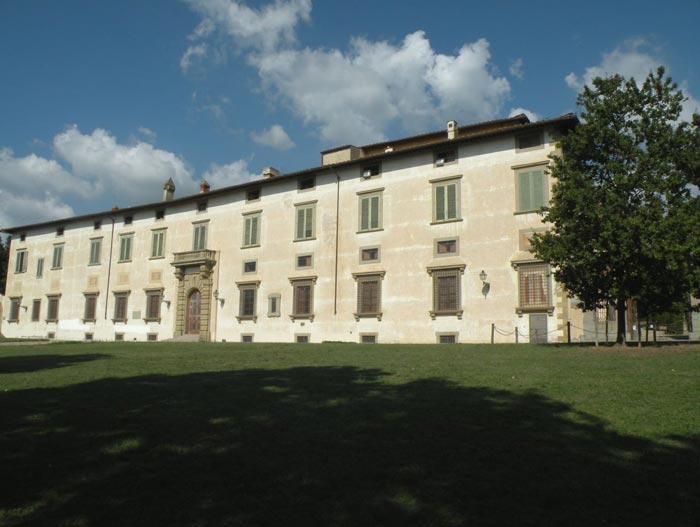 |
||
Villa Reale di Castello (Villa di Castello) in Firenze |
||
The Villa di Castello, in the hills near Florence, Tuscany, central Italy, was the country residence of Cosimo I de' Medici, Grand Duke of Tuscany (1519-1574). The gardens, filled with fountains, statuary, and a grotto, became famous throughout Europe. The villa also housed some of the great art treasures of Florence, including Sandro Botticelli's Renaissance masterpieces The Birth of Venus and Primavera. The gardens of the Villa had a profound influence upon the design of the Italian Renaissance garden and the later French formal garden.
|
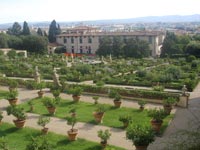 |
|
|
||
Villa Petraia |
||
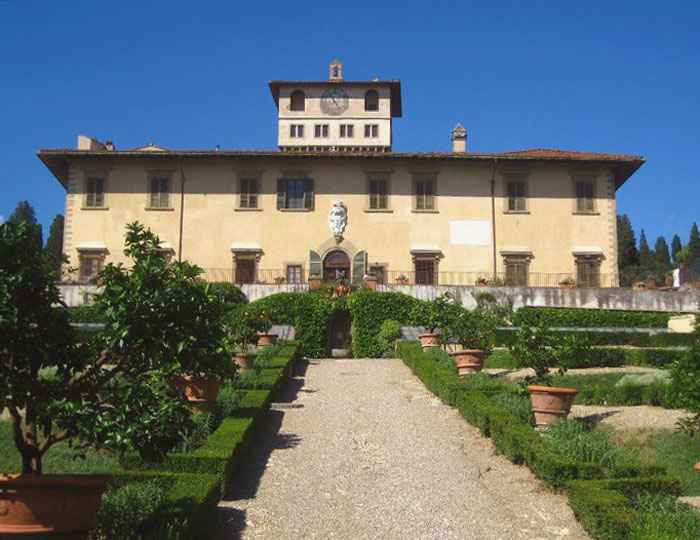 |
||
Villa La Petraia |
||
| Located just outside Florence, Villa La Petraia is one of the most enchanting Medici villas, with its outstanding country setting, sublime pictorial decorations and panoramic formal gardens. Originally an ancient fortified residence, which preserves its great tower, it was enlarged at the end of the 16th century to create the present villa with its beautifully designed terraced garden. The courtyard of the villa, which was roofed over in the 19th century, is decorated with frescoes by Volterrano and Cosimo Daddi. The famous bronze statue of Venus/Florence by Giambologna, which originally stood above the fountain in the garden of the Medici Villa of Castello, is now exhibited inside. The Medici family purchased the villa in the middle of the 16th century. Around 1566-1568, Cosimo I had the complex restructured, and gave it to his son Ferdinando I (first cardinal, and later Grand Duke) who completed the works. The garden in front of the villa, done on a project by Tribolo, develops on three superimposed terraces, created by means of major infill works. |
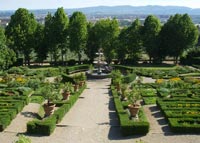 |
|
|
||
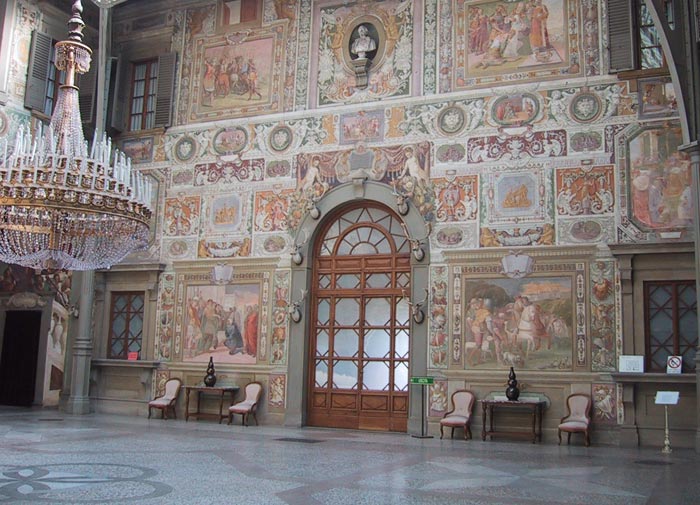 |
||
Villa La Petraia, the courtyard, frescoes by Cosimo Daddi - early 17th century - |
||
|
||
Villa di Fiesole |
||
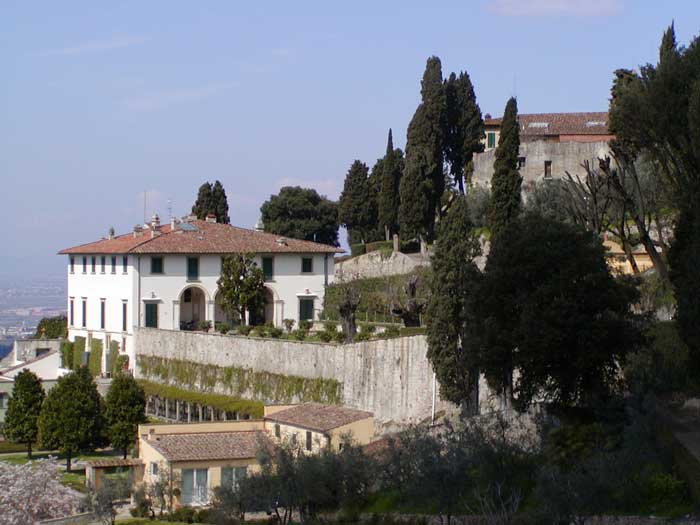 |
||
Villa Medici in Fiesole, Firenze |
||
| The Medici Villas have maintained their original characteristics unchanged, expressing the particular measurement and refined taste of the Florentine culture during both the Renaissance and Baroque periods. The Villa Medici in Fiesole, one of the oldest Renaissance residences with a garden, is also one of the best preserved, but at the same time is also one of the least well known. While most of the villas dating back to the same period, such as Cafaggiolo and Trebbio, stand at the centre of farming concerns, this villa had no connections at all with agricultural life. The Villa Medici was built during the mid fifteenth century when Cosimo hired Michellozzo Di Bartolommeo to design the Villa for his son Giovanni Medici. Intended to be a setting for intellectual life rather than a working Villa, Villa Medici was constructed to be a demonstration of aesthetic and ideological values. Villa Fiesole was designed by Michelozzo (1458-1461) and it still appears in great conditions. The residence is gently placed on the hills surrounding Florence and the panoramic view is outstanding. The geographical position of the villa on gently sloping land suggested the layout of the garden on three terraces. The first of these, at the end of an avenue lined with cypress trees that runs underneath a holm-oak wood, has large rectangular lawns with potted lemon trees. The villa's piano nobile looks out onto this part of the garden. The second terrace is overlooked by the rear of the building and is reached by an indoor staircase. This, the least heavily altered part of the garden, has flower beds lined with box hedges with a large fountain in the centre, and is laid out in the shade of large magnolia trees. The third terrace, created between 1911 and 1923 by Cecil Pinsent and Geoffrey Scott is aligned longitudinally with the first, but is 11-12 m lower down. [2] It is laid out in the Italian style, with a fine pergola positioned mid-way between the two levels. Below the lemon garden is an unpaved walk which leads to the pergola which runs the length of another retaining wall. The pergola walks leads to the western terrace and the giardino segreto, or "secret garden." Gardens in Tuscany | Villa Medici di Fiesole Address: Via Beato Angelico 2, Fiesole (FI) |
|
|
|
||
Villa La Quiete |
||
 |
||
Gardens of Villa La Quiete [3] |
||
| n Address: Via di Boldrone 2, Castello (FI) Open only upon request. |
||
|
||
Villa Corsini di Mezzomonte |
||
 |
||
| Villa Corsini di Mezzomonte, situated in the countryside near Impruneta, which belonged to the Buondelmontis and the Medicis, before being acquired by the Corsini family. Fattoria Corsini di Mezzomonte, a farm, adjoining the ex Villa Medicea, has been owned by the Corsini family since 1647. In Tuscany, the Corsini family has a long tradition in the agricultura Address: Via Imprunetana per Pozzolatico 116, Impruneta, Firenze |
l field. Villa La Medicea, an old Renaissance villa, is also part of the estate of Villa di Mezzomonte which belonged to the Medici family before passing to the Corsini family. Converted into the Renaissance style by Lorenzo Il Magnifico, the estate has welcomed famous people and hosted important events over the centuries. |
|
|
||
Villa di Camugliano |
||
| n Address: Via Camugliano, Ponsacco, Pisa |
||
|
||
Villa Poggio Imperiale |
||
| n Address: Piazzale del Poggio Imperiale, Firenze |
||
|
||
Villa di Pratolino and Park |
||
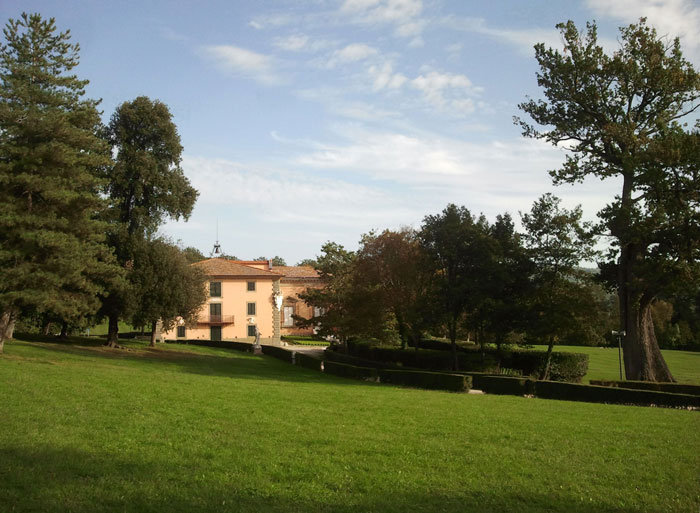 |
||
Villa Demidoff is the current name of the ancient Medicean Paggeria of Pratolino. Located on the Florentine hills along the Via Bolognese heading into the Mugello valley, the estate in Pratolino was bought by Francesco I de' Medici in 1568, who entrusted Buontalenti with the task of transforming it into a villa. Legend has it that Francesco bought it as a gift for his second wife Bianca Cappello with the idea of turning it into a fairy-tale property.
|
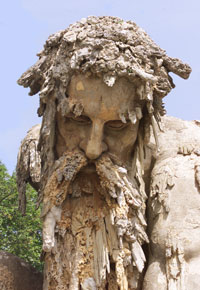 |
|
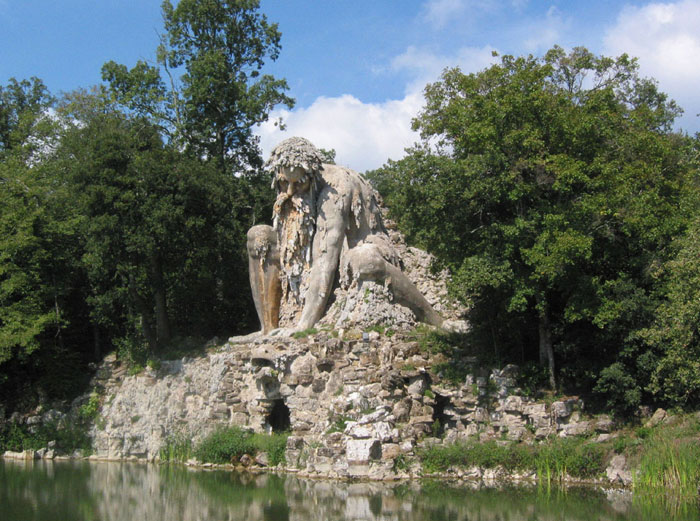 |
||
Giambologna, sculpture of Appennino, Il Colosso dell'Appennino,
|
||
|
||
| n Address: Via di Lappeggi 26, Bagno A Ripoli, Firenze |
||
Villa dell'Ambrogiana |
||
| n Address: Viale Umberto I, Montelupo Fiorentino, Firenze |
||
Villa la Magia |
||
Villa Medicea La Magia, Quarrata [3]
|
||
Villa La Magia ligt in de gemeente Quarrata, vlakbij het centrum in via Vecchia Fiorentina n. 63 en het was een belangrijke Medici-villa. De naam is waarschijnlijk afgeleid van maia, de vrouwelijke vorm van maius, 'groot', en was bedoeld als naam voor de belangrijkste villa in de omgeving. De oorspronkelijke kern van de villa werd in de veertiende eeuw gebouwd door de familie Panciatichi uit Pistoia, in de Ombrone-vallei op de noordelijke hellingen van Montalbano, een reeks heuvels die de zuidelijke grens vormen van de vlakte die Prato, Pistoia en Florence omvat. Het is een strategisch belangrijke plek waar in 1536 tijdens een jachtpartij een historische ontmoeting plaatsvond tussen hertog Alessandro de' Medici en keizer Karel V. In 1581 ging de familie Panciatichi failliet en enkele jaren later, in 1583, ging het landgoed over op de Medici. Francesco I wilde het landgoed van de familie op het grondgebied van het Groothertogdom geleidelijk uitbreiden. De ligging was bijzonder gunstig omdat het jachtgebied grensde aan dat van Poggio a Caiano, Artimino, Ambrogiana en Montevettolini, in een systeem van satellietvilla's rond Montalbano, waar zich het koninklijke jachtreservaat, de "Barco Mediceo", bevond. Vanaf 1584 werd het gerenoveerd door Bernardo Buontalenti, hofarchitect, en vergeleken met andere villa's ziet het er nu vrij eenvoudig uit. In 2000 werd Villa La Magia gekocht door de gemeente Quarrata, die een restauratieproject startte dat in 2005 werd voltooid. Er werden hedendaagse kunstwerken aangekoch, mert werken van Fabrizio Corneli, Anne en Patrick Poirier, Marco Bagnoli, Hidetoshi Nagasawa, Maurizio Nannucci en Daniel Buren die goed werden geîntegreerd in het park.
|
Daniel Buren, Muri Fontane a tre colori per un esagono, mai 2011, travail in situ permanent, Villa Medicea La Magia, Quarrata
|
|
|
||
Forte di Belvedere |
||
| n Address: Via di San Leonardo 1, Firenze |
||
|
||
Villa di Careggi |
||
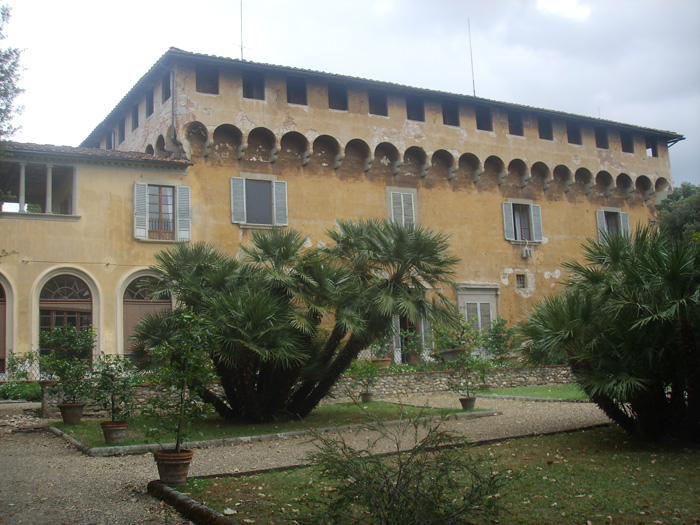 |
||
Villa Medici at Careggi |
||
| The Villa Medici at Careggi nestles behind a high wall and is famed as the place where Cosimo de' Medici (1389-1464) assembled his Platonic academy. The Gardens, have undergone several radical changes over the years, including one in the nineteenth century. The gardens of the Villa at Careggi were already important in the day of Lorenzo the Magnificent and therefore were designed in accordance with ideals that can be traced to antiquity. Unfortunately, not a trace remains of the original layout because the gardens, like the villa, had been redesigned several times. Bought by the Medici family in 1417, the villa was inherited following the death of Giovanni di Bicci dei Medici by his son Cosimo the Elder, who commissioned Michelozzo to renovate the property. A great deal of work was done, the focus of attention being the characteristically trapezoid court, with loggias. Michelozzo also created the loggias on the upper floors, opening the building up to the garden and the surrounding countryside. Cosimo, the most celebrated of all the Medicis, died here in 1464. The first to mention Michelozzo’s work on the villa at Careggi was Giorgio Vasari who, after describing the Villa del Trebbio, wrote: “E similmente, lontano da Firenze due miglia, fece il palazzo della villa di Careggi, dove Michelozzo condusse l’acqua per la fonte che al presente si vede”. As we enter the Villa we first see the Cortile and loggia which is certainly the fulcrum of Michelozzo’s design. We are immediately struck by the unusual, trapezoidal shape of the courtyard which is congruent with the path of the road (in fact, at the time the work was being done, the main road was tangential to the entrance). The two lateral wings of the west façade are also attributed to Michelozzo. They are lower than the central structure and project towards the garden. On the ground floor there are two loggias with three arches supported by composite style capitals and columns which are similar to those in the internal courtyard. Lorenzo the Magnificent was born at the Careggi villa in 1448, and after the death of Cosimo the Elder (1464) he became the head of the family. Careggi was his favorite residence and he transformed it into a center of culture and the arts by establishing the Neoplatonic Academy. Following the death of Lorenzo the Magnificent, the fall of Savonarola and the banishment of the Medicis from Florence, most of their lands and buildings were confiscated. Although this was not the fate of the Villa at Careggi, it changed hands through inheritance several times. Finally it was inherited by the Duke Alessandro in 1534 and was remodeled again. When the Grand Duke Cosimo I became the proprietor, the villa lost its former splendor: he preferred the Villa del Trebbio to such an extent that in 1569 he gave the entire Careggi estate to his son Pietro. The Grand Duke Ferdinando died in 1609 and the villa went to Prince Carlo who, after being made a cardinal in 1615, undertook an enormous project to remodel the villa and the gardens.[5] The Medici inventory of 1492 records the Entombment of Christ hanging in the Medici villa in Careggi. The figure of Nicodemus, dressed in expensive clothing and gazing out towards the spectator, has been identified as a portrait of Cosimo. Cosimo also owned Rogier's small panel of the Virgin with the Child and Four Saints, painted in 1450, the year Rogier visited Italy, though there is no direct evidence that Rogier ever visited Florence. The work follows the Entombment of Christ from the predella of Fra Angelico's San Marco Altarpiece, painted around 1440. Fra Angelico's influence is evident in the display of the dead man, shown almost standing, with Mary and John holding his arms one on each side, and more particularly in the hill with the tomb in the rock, unusual in Flemish art. The San Marco altarpiece was itself an important piece of Medici patronage. Address: Viale Gaetano Pieraccini 17, Firenze Gardens in Tuscany | Art in Villa Medici at Careggi |
|
|
|
||
Villa di Cerreto Guidi |
||
The villa is situated near to the Fucecchio Marshes, a humid area rich in fauna. It was built in 1556 by Cosimo I as a fortified hunting lodge. The building, which has a double ramp in brick leading up to the entrance, is attributed to the architect Buontalenti.
|
||
|
||
Palazzo Mediceo di Seravezza |
||
 |
||
Palazzo Mediceo di Seravezza |
||
| The palace of Seravezza is a residence of the Medici family. On order of Cosimo I de’ Medici, it was built between 1560 and 1564 by Bartolomeo Ammannati or, as recently argued for the resemblance of several architectural elements with the Villa of Artimino, by a young Bernardo Buontalenti. The building was erected in an area particularly important for extracting minerals and quarrying marble from Monte Altissimo. The building presents itself as a fortified palace and was to serve as a resting place for the Duke when he came to visit the caves. The use of marble in the cornices of the windows should not be considered a sign of splendour as there was an abundance of marble in Seravezza. Today, the public library and the Museum of work and popular traditions of historic Versilia Important contemporary and modern art exhibitions are also held here.n Address: Via 24 Maggio 22, Seravezza, Lucca | www.terremedicee.it |
||
|
||
|
||
|
||
|
||
|
||
|
||
Podere Santa Pia is a peaceful retreat, perfect for relaxing and enjoying the splendor of the Tuscany countryside. Enjoy the exquisite art, museums and churches in the nearby cities, then relish the cuisine and epic countryside. Podere Santa Pia highlights the best of the quintessential Italian region. Hidden secrets in Tuscany | Holiday house Podere Santa Pia
|
||
|
||
